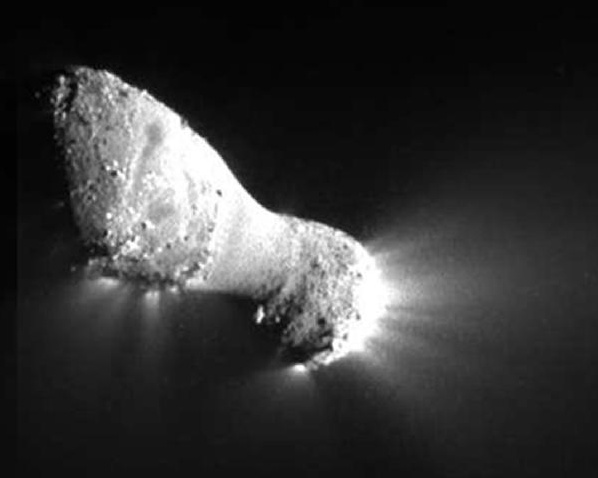Comet Hartley
November 8, 2010
When I hear the name, Hartley, I first think of
Mariette Hartley, who was the memorable character, Lyra-a, the woman with two hearts (and two navels), in the forgettable made-for-TV movie,
Genesis II (1973, John Llewellyn Moxey, Director).
Gene Roddenberry wrote the script for this movie, which was a pilot for a television series that never materialized. Mariette Hartley was a staple in 1970s-era television, acting in such series as
Bonanza,
Gunsmoke,
Mannix,
The Rockford Files and
The Bob Newhart Show. You can watch her in a 1979 Polaroid commercial in this
YouTube video.
After the nostalgia wears off, my technical brain kicks-in, and I think of the
Fast Hartley Transform (a.k.a., the Discrete Hartley Transform, or DHT). Unlike the
Discrete Fourier transform, the DHT transforms real numbers to real numbers, and it's useful for
spectral analysis of audio signals.
Now there's a new Hartley to add to my memory banks. Malcolm Hartley is an astronomer at the
Siding Spring Observatory's UK Schmidt telescope in
New South Wales, Australia.[1] On March 16, 1986, he discovered a
comet while reviewing a
glass photographic plate. These were the days before
high resolution digital cameras facilitated
astrophotography. Hartley was eventually a discover, or co-discover, of ten comets before his telescope was repurposed for
spectroscopy in 2002.
In 2009, Hartley learned from an editor of
Science that his first comet, called
Hartley 2 (officially, 103P/Hartley), had been selected for a close encounter with the
NASA Deep Impact spacecraft during it's extended
EPOXI mission.[2] Hartley was invited by NASA to the
Jet Propulsion Laboratory to witness the close encounter with his comet that occurred last week.[2-6]

Image of Comet Hartley 2 from a distance of about 435 miles. The comet's nucleus is approximately 1.2 miles long, and a quarter mile wide at the "neck." (Image: NASA/JPL-Caltech/UMD).
Deep Impact was the spacecraft that shot a missile into comet
Tempel 1, on July 4, 2005, a fitting day for cosmic fireworks. The 820 pound copper missile punched a crater into Tempel 1, and the ejected plume allowed an analysis of the comet's composition, much like the
Lunar Crater Observation and Sensing Satellite (LCROSS) encounter with the moon's
Cabeus crater that I wrote about in a
previous article (New Moon, October 25, 2010). Deep Impact passed within 435 miles of Hartley 2 on November 4, 2010, when it was 23 million miles from Earth, quite close by solar system standards. The comet, which orbits the sun in a period of just six and a half years, had actually passed within 11 million miles from Earth the month before.
Hartley 2 was chosen for Deep Impact's second rendezvous since it's a small comet. Its volume is about 100 times smaller than that of its first target, Tempel 1, and it was a very active comet, ejecting quite a bit of material into its tail.[4] The comet had quite a few surprises, such as its atmosphere of
cyanide gas and
carbon dioxide which is quite unlike just the
water ice that's been seen for larger comets and was present in Hartley 2 as well.[5] This might be linked to its small size and the fact that its outer layers have already evaporated. Michael A'Hearn, the mission's lead scientist, says that Hartley loses three to four feet of its surface after each orbit around the sun, and it doesn't have too much life left in it.[5]
Photographs of the comet show a dogbone shape, and scientists expect to have 120,000 images of Hartley 2, some of higher resolution than the initially released images, by
Thanksgiving.[4,5] This is a far cry from
Mariner 4, the first successful Mars probe, that sent back only 21 images in 1965. The mission will likely be terminated at that time, since there isn't enough fuel for another flyby.[6]
References:
- D. C. Agle, "The Man Behind Comet Hartley 2," JPL Press Release No. 2010-368, November 02, 2010.
- NASA EPOXI Mission Site; EPOXI Mission Site.
- Nasa spacecraft comes within 435 miles of comet, Telegraph (UK), November 5, 2010.
- Amina Khan, "Space probe captures 'amazing' images of comet Hartley 2," Los Angeles Times, November 04, 2010.
- Pete Spotts, "Comet Hartley 2 flyby yields stunning photos of a cosmic oddball," Christian Science Monitor, November 4, 2010.
- Bill Chappell, "Spacecraft Beams Sharp Photos Of Comet's Core To NASA, National Public Radio, November 4, 2010.
Permanent Link to this article
Linked Keywords: Mariette Hartley; Genesis II; Gene Roddenberry; Bonanza; Gunsmoke; Mannix; The Rockford Files; The Bob Newhart Show; Fast Hartley Transform; Discrete Fourier transform; spectral analysis; Siding Spring Observatory; United_Kingdom; UK; Schmidt telescope; New South Wales, Australia; comet; glass photographic plate; Charge-coupled_device; high resolution digital cameras; astrophotography; spectroscopy; Science; 103P/Hartley; Hartley 2; NASA; Deep Impact spacecraft; EPOXI mission; Jet Propulsion Laboratory; Tempel 1; Lunar Crater Observation and Sensing Satellite; LCROSS; Cabeus crater; cyanide gas; carbon dioxide; water ice; Thanksgiving; Mariner 4.